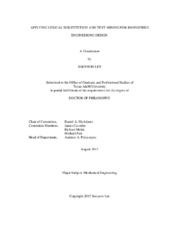| dc.description.abstract | Nature has repeated its evolution processes and developed its own “engineering” principles over a long period of time. Bioinspired design starts from the belief that nature has the most effective and optimized problem-solving schemes, which can be applied to human problems directly or indirectly. In summary, bioinspired design is the study of the design process, adapting the structure, behavior, or organic mechanisms of biology to engineering problems.
In bioinspired design studies, researchers have sought a way of improving concept generation through texts. Generally, there are two problems in text-based bioinspired design. First, there is a great lexical gap between two areas—biology and engineering. Thus, understanding the context of biological text is compromised, prohibiting analogical transfer between the two domains. Second, the amount of text is too great to be assimilated by engineers. This knowledge gap makes the engineer confused by the extensive information and slows down the design process.
The present work tried to apply lexical substitution and text mining theories to effectively process biological text. Regarding the matter of the lexical gap, this research developed an algorithm that translates biological terminology to words or phrases that are understandable to engineers by adapting four lexical sources: WordNet, Wikipedia, the Integrated Taxonomy Information System (ITIS), and WordNik. For the second problem, this research tried to categorize biological text based on morphological solutions by adapting the Latent Semantic Analysis (LSA) technique.
Two main contributions are made in this dissertation. First of all, this work is the first attempt to directly bridge the lexical gap between biology and engineering by translating biological terminology. The existing approach to bioinspired design study involves building a thesaurus or database that connects a few engineering keywords and their biological correspondences. However, since most other biological terms remain unchanged, this research is meaningful as it attempts to overcome this limitation. The second contribution is that this research ameliorates the natural language-based bioinspired concept generation. Specifically, the accessibility to biotexts for bioinspired design seems to be improved by enabling engineers to selectively acquire biological information for their problems. | en |


